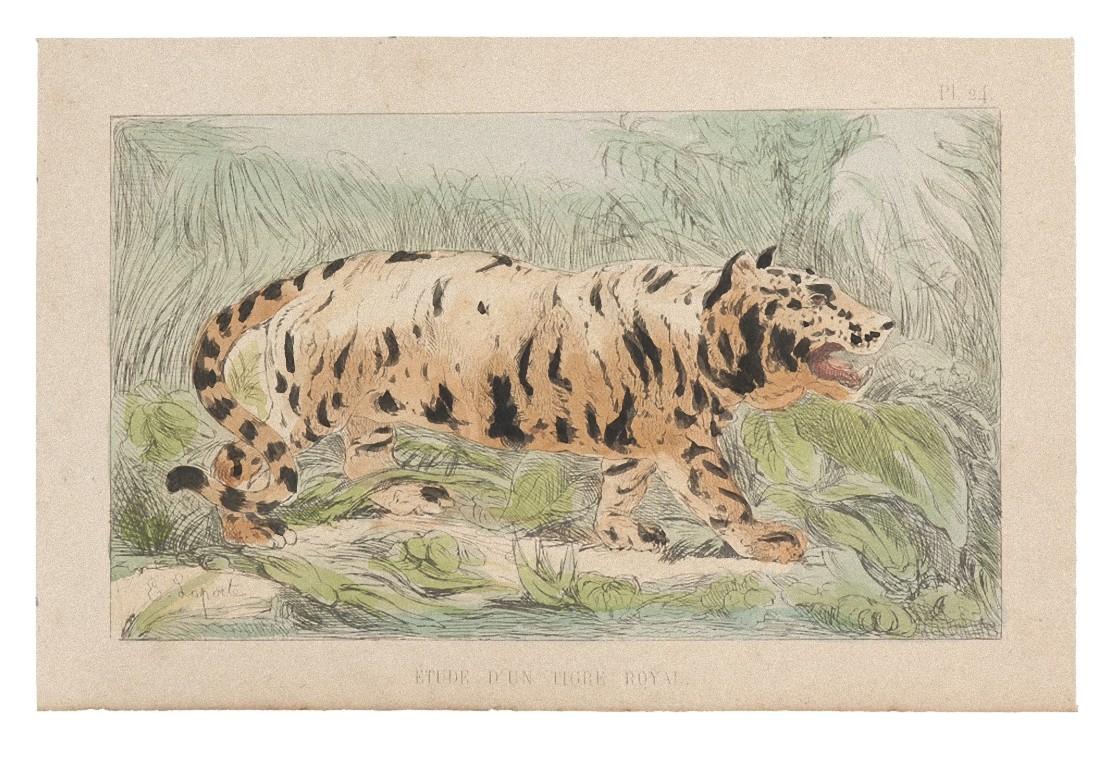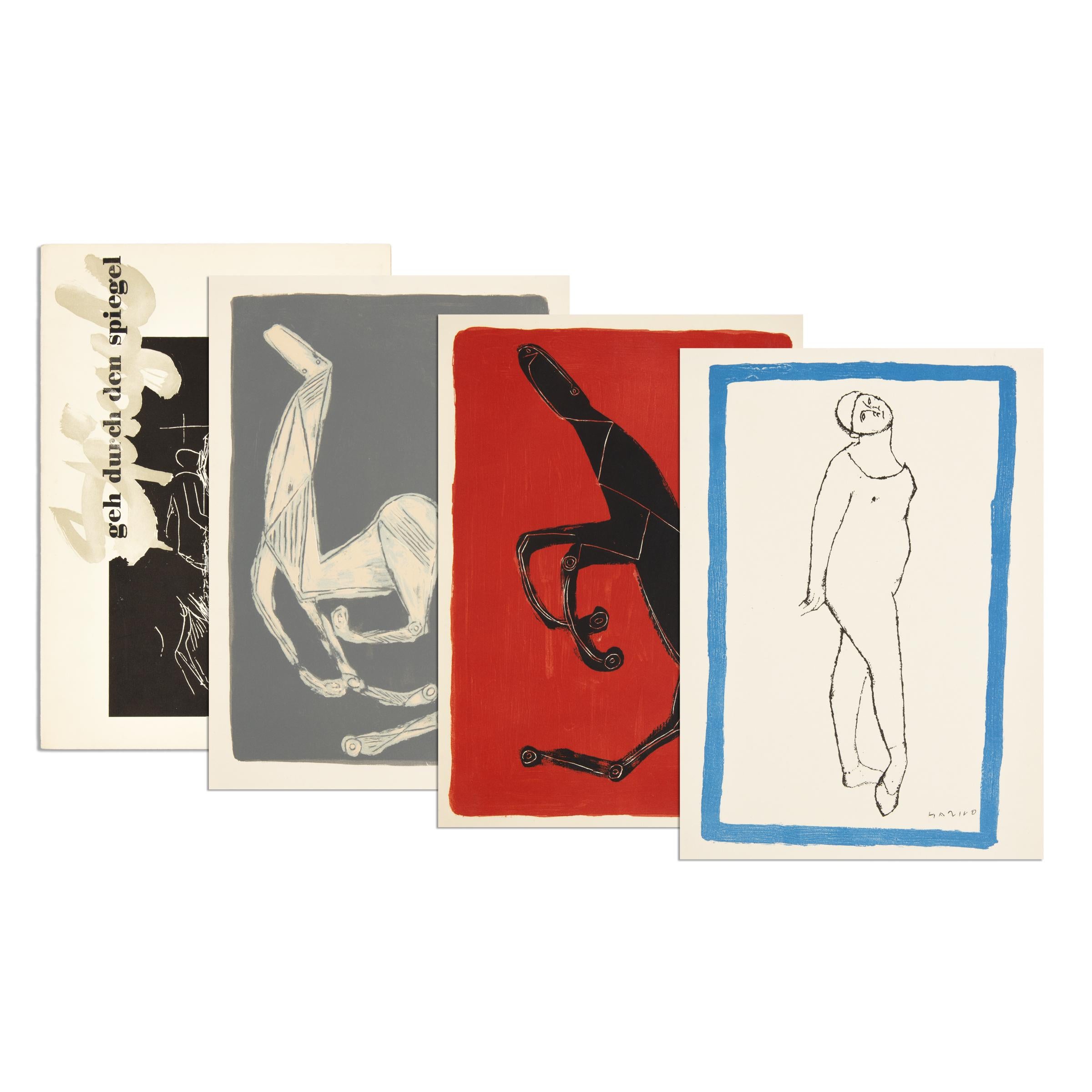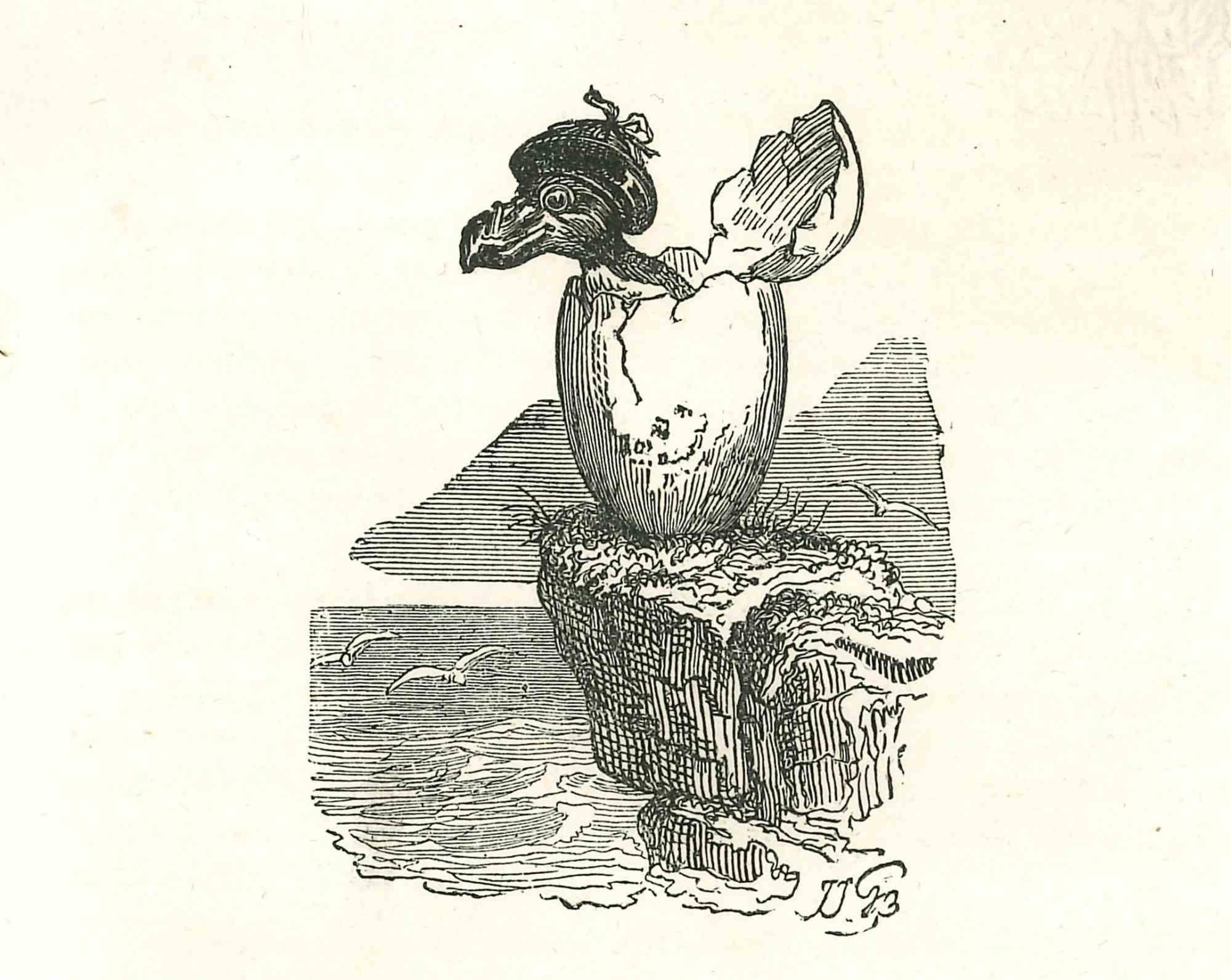Items Similar to The Cat - Lithograph by Giselle Halff - 1950s
Want more images or videos?
Request additional images or videos from the seller
1 of 5
Giselle HalffThe Cat - Lithograph by Giselle Halff - 1950s1950s
1950s
About the Item
The Cat is a lithograph on ivory-colored paper realized by Giselle Halff in 1950 ca.
Hand-signed by pencil on the lower right.
Numbered. Edition, 19/20.
Good conditions, slight foxing.
The cat is represented through deft expressive strokes, characterized by harmonious negative and positive space filled with black, with emphasis on the smooth form of the cat's body and recalling its movement aesthetically.
- Creator:Giselle Halff (French)
- Creation Year:1950s
- Dimensions:Height: 19.3 in (49 cm)Width: 14.97 in (38 cm)Depth: 0.04 in (1 mm)
- Medium:
- Movement & Style:
- Period:
- Framing:Framing Options Available
- Condition:Insurance may be requested by customers as additional service, contact us for more information.
- Gallery Location:Roma, IT
- Reference Number:
About the Seller
4.9
Platinum Seller
These expertly vetted sellers are 1stDibs' most experienced sellers and are rated highest by our customers.
1stDibs seller since 2017
6,822 sales on 1stDibs
Typical response time: 3 hours
- ShippingRetrieving quote...Ships From: Grasse, France
- Return PolicyA return for this item may be initiated within 14 days of delivery.
More From This SellerView All
- The Tiger - Original Lithograph by Emile Henri Laporte - 1860By Emile Henri LaporteLocated in Roma, ITThe Tiger is an original modern artwork realized in 1860 by the French artist Emile Henri Laporte (1841 - 1919). Original colored Lithograph on paper. Han...Category
1970s Modern Figurative Prints
MaterialsLithograph
- Good Night Darling Mouses - Original Lithograph by J.J. Grandville - 1852Located in Roma, ITGood Night Darling Mouses is an original lithographs on ivory-colored paper realized by J.J. Grandville from Scènes de la vie privée et publique des animaux, 1852. Published by Manes...Category
1850s Modern Figurative Prints
MaterialsLithograph
- The Birth of the Bird - Original Lithograph by J.J Grandville - 1852By Jean Jeacques GrandvilleLocated in Roma, ITThe Birth of the Bird is an original lithograph on ivory-colored paper realized by J.J. Grandville from Scènes de la vie privée et publique des animaux, 1852. Published by Manesq & H...Category
1850s Modern Animal Prints
MaterialsLithograph, Paper
- The Beetles General and Guards - Original Lithograph by J.J Grandville - 1852By Jean Jeacques GrandvilleLocated in Roma, ITThe Beetles General and Guards - Animal Fable is an original lithographs on ivory-colored paper realized by J.J. Grandville from Scènes de la vie privée et...Category
1850s Modern Animal Prints
MaterialsLithograph, Paper
- Miss. Wolf Greeting Mr. Hedgehog - Original Lithograph by J.J Grandville-1852By Jean Jeacques GrandvilleLocated in Roma, ITMiss. Wolf Greeting Mr. Hedgehog is an original lithographs on ivory-colored paper realized by J.J. Grandville from Scènes de la vie privée et publique des animaux, 1852. Published b...Category
1850s Modern Animal Prints
MaterialsLithograph, Paper
- The Concert In The Wood With Grasshoppers Violinist And.. by J.J Grandville-1852By Jean Jeacques GrandvilleLocated in Roma, ITThe Concert In The Wood With Grasshoppers Violinist And Fly Cellist is an original lithograph on ivory-colored paper realized by J.J. Grandville from Scènes de la vie privée et publ...Category
1850s Modern Animal Prints
MaterialsLithograph, Paper
You May Also Like
- Marino Marini, Geh durch den Spiegel: Catalogue including 3 Original LithographsBy Marino MariniLocated in Hamburg, DEMarino Marini (Italian, 1901-1980) Geh durch den Spiegel 1, 1954 Catalogue including 3 lithographs on paper (loose, mounted) 38 x 26 cm Markings: Each sheet signed in plateCategory
Mid-20th Century Modern Figurative Prints
MaterialsLithograph
- "Présure Guillien, Dijon Cow, " Original Color Lithograph Poster by L. SerreLocated in Milwaukee, WI"Présure Guillien, Dijon Cow" is an original color lithograph poster. The artist's name is printed in the lower left, and the name of the printing company, Havas, is printed in the lower right. The poster advertises rennet, a product used to curdle milk and make cheese, featuring a milk maid with a red kerchief tied around her head in front of a white cow. She holds a golden bucket...Category
1920s Modern Figurative Prints
MaterialsLithograph
- Etude pour l'Homme au MoutonBy Pablo PicassoLocated in Long Island City, NYLithograph created by Daniel Jacomet based on the drawing of March 30, 1943, belonging to the portfolio La Flute Double Artist: Pablo Picasso (after), Spa...Category
1960s Modern Figurative Prints
MaterialsLithograph
- Georges Braque - Original LithographBy Georges BraqueLocated in Collonge Bellerive, Geneve, CHGeorges Braque - Original Lithograph 1963 Dimensions: 32 x 24 cm Andre Sauret, Monte Carlo The father of Cubism Three Cubist that distinguishes art historian periods were initiated and developed by Georges Braque: The Cubist Cézanne (1907-1909), Executive (1909-1912) and synthetic (1912-1922). Post-Impressionist and fawn, Braque no longer adheres to the contingency of a decorative way or the other. Cézanne’s paintings exhibited at the Grand Palais during the retrospective of 1907 are a revelation: Cézanne sought and invented a pictorial language. In his footsteps, Braque went to the South with the reasons of the Master. He returned with Estaque landscapes and surprising Ciotat it keeps Cezanne geometric model and retains the “passages” continuity from one surface to another to create the sensation of “turning around” of the object represented. But he wants to go after the consequences of the vision of Cezanne. In his paintings Houses in L’Estaque (1908) it simplifies the volumes of houses, neglects detail by removing doors and windows: the plastic rhythm that builds the table. Large Nude , a masterpiece of the period, can be considered the first work of Cézanne cubism . Systematizing and deepening Braque discoveries open the door analytical cubism. In 1909, his painting became more cerebral than sensual. The pattern is recreated in the two-dimensionality of the canvas, leaving aside any illusionistic perspective. In Still Life with Violin, objects are analyzed facets according to their characteristic elements, each facet referring to a particular view of the object. There are so many facets of points selected view: Table reflects the knowledge of the object and the ubiquity of the eye. Moreover, Braque is looking for the essence of the objects in the world rather than their contingency, which explains the absence of light source and use of muted colors (gray, ocher), contingent aspects of the object . But formal logic has stepped facets, erased any anecdote to the object and ultimately led to his painting a hermetic more marked on the edge of abstraction (see the series of Castle Roche-Guyon ). Braque, anxious to keep the concrete and refusing at all costs that the logic of Cubism takes the paintings to abstract, reintroduced signs of reality in his paintings in 1912 marks the beginning of Synthetic Cubism. Historians speak of “signs of real” rather than reality because what interests Braque, this is not to put reality into a table, but to create a painting which, by its language, refers to the real. To do this, he invented two major techniques XX th century inclusions and contributions. The inclusions consist of painting objects that have no real depth, materials (wallpaper in Nature morte aux playing cards faux wood is a pictorial inclusion) or letters (calligraphic inclusion in Portuguese ), made first brush and a few months later stencil. Contributions are defined in contrast with the collage on canvas of foreign materials: glued or sand paper, sawdust, etc.. Regarding the collages, Braque used for the first time in September 1912 a piece of adhesive paper imitating faux wood Compote and Glass , then the packet envelope of tobacco Bock in 1912-1913, or an advertisement in Damier , 1913). Inputs and inclusions refer to an external object in the table, without “emulate” this object. Away from their appearances, objects are represented in closest essence of the objects in the real world sense. This is also the time of Synthetic Cubism that Braque invented paper sculpture. There are, unfortunately, and no one is living proof of a photograph makes it possible to realize: Paper and paperboard. Métamorphoses period(1961-1963). In 1961, Georges Braque worked on a Greek head for the Louvre, which obsesses him, and he wishes to free his mind. He tried several times to bring out the paint and the result was unsatisfactory. He thinks the ultimate metamorphosis its Greek head projected in three dimensions. He calls in his studio of Baron Heger Loewenfeld, master lapidary, and he communicates his enthusiasm during the “fateful encounter.” Nine months later, in honor of the eighty years of Georges Braque, Heger Loewenfeld offers the Master of the ring Circe: the famous Greek head finally exorcised, carved in an onyx. Braque Loewenfeld then asked to identify other issues that haunt him. From dated and signed by Georges Braque, Heger gouaches Loewenfeld shapes works in the fields of jewelery, lapidary art...Category
1960s Modern Figurative Prints
MaterialsLithograph
- Georges Braque - Original LithographBy Georges BraqueLocated in Collonge Bellerive, Geneve, CHGeorges Braque - Original Lithograph 1963 Dimensions: 32 x 24 cm Andre Sauret, Monte Carlo The father of Cubism Three Cubist that distinguishes art historian periods were initiated and developed by Georges Braque: The Cubist Cézanne (1907-1909), Executive (1909-1912) and synthetic (1912-1922). Post-Impressionist and fawn, Braque no longer adheres to the contingency of a decorative way or the other. Cézanne’s paintings exhibited at the Grand Palais during the retrospective of 1907 are a revelation: Cézanne sought and invented a pictorial language. In his footsteps, Braque went to the South with the reasons of the Master. He returned with Estaque landscapes and surprising Ciotat it keeps Cezanne geometric model and retains the “passages” continuity from one surface to another to create the sensation of “turning around” of the object represented. But he wants to go after the consequences of the vision of Cezanne. In his paintings Houses in L’Estaque (1908) it simplifies the volumes of houses, neglects detail by removing doors and windows: the plastic rhythm that builds the table. Large Nude , a masterpiece of the period, can be considered the first work of Cézanne cubism . Systematizing and deepening Braque discoveries open the door analytical cubism. In 1909, his painting became more cerebral than sensual. The pattern is recreated in the two-dimensionality of the canvas, leaving aside any illusionistic perspective. In Still Life with Violin, objects are analyzed facets according to their characteristic elements, each facet referring to a particular view of the object. There are so many facets of points selected view: Table reflects the knowledge of the object and the ubiquity of the eye. Moreover, Braque is looking for the essence of the objects in the world rather than their contingency, which explains the absence of light source and use of muted colors (gray, ocher), contingent aspects of the object . But formal logic has stepped facets, erased any anecdote to the object and ultimately led to his painting a hermetic more marked on the edge of abstraction (see the series of Castle Roche-Guyon ). Braque, anxious to keep the concrete and refusing at all costs that the logic of Cubism takes the paintings to abstract, reintroduced signs of reality in his paintings in 1912 marks the beginning of Synthetic Cubism. Historians speak of “signs of real” rather than reality because what interests Braque, this is not to put reality into a table, but to create a painting which, by its language, refers to the real. To do this, he invented two major techniques XX th century inclusions and contributions. The inclusions consist of painting objects that have no real depth, materials (wallpaper in Nature morte aux playing cards faux wood is a pictorial inclusion) or letters (calligraphic inclusion in Portuguese ), made first brush and a few months later stencil. Contributions are defined in contrast with the collage on canvas of foreign materials: glued or sand paper, sawdust, etc.. Regarding the collages, Braque used for the first time in September 1912 a piece of adhesive paper imitating faux wood Compote and Glass , then the packet envelope of tobacco Bock in 1912-1913, or an advertisement in Damier , 1913). Inputs and inclusions refer to an external object in the table, without “emulate” this object. Away from their appearances, objects are represented in closest essence of the objects in the real world sense. This is also the time of Synthetic Cubism that Braque invented paper sculpture. There are, unfortunately, and no one is living proof of a photograph makes it possible to realize: Paper and paperboard. Métamorphoses period(1961-1963). In 1961, Georges Braque worked on a Greek head for the Louvre, which obsesses him, and he wishes to free his mind. He tried several times to bring out the paint and the result was unsatisfactory. He thinks the ultimate metamorphosis its Greek head projected in three dimensions. He calls in his studio of Baron Heger Loewenfeld, master lapidary, and he communicates his enthusiasm during the “fateful encounter.” Nine months later, in honor of the eighty years of Georges Braque, Heger Loewenfeld offers the Master of the ring Circe: the famous Greek head finally exorcised, carved in an onyx. Braque Loewenfeld then asked to identify other issues that haunt him. From dated and signed by Georges Braque, Heger gouaches Loewenfeld shapes works in the fields of jewelery, lapidary art...Category
1960s Modern Figurative Prints
MaterialsLithograph
- Alfred Manessier - LithographBy Alfred ManessierLocated in Collonge Bellerive, Geneve, CHAlfred Manessier - Lithograph 1962 From the art periodical XXe Siecle (no. 20) Dimensions: 32 x 24 Edition: G. di San Lazzaro. Unsigned and unnumbered as issuedCategory
1960s Modern Figurative Prints
MaterialsLithograph
Recently Viewed
View AllMore Ways To Browse
The Cat
Retro 1950s Space Art
Saint Jean Paul
Picasso Screen
Vintage Comic Paper
Vintage Original Posters Political
Broken Glass Art
Cat Woman
Retro Love Pop Art
S Glass Window
15th Spain
15th Spanish
Dali Drawing Original
Glass Paul Sculpture
Lithograph Set Of 3
Picasso The Artist And His Model
1937 Picasso
German Musician





